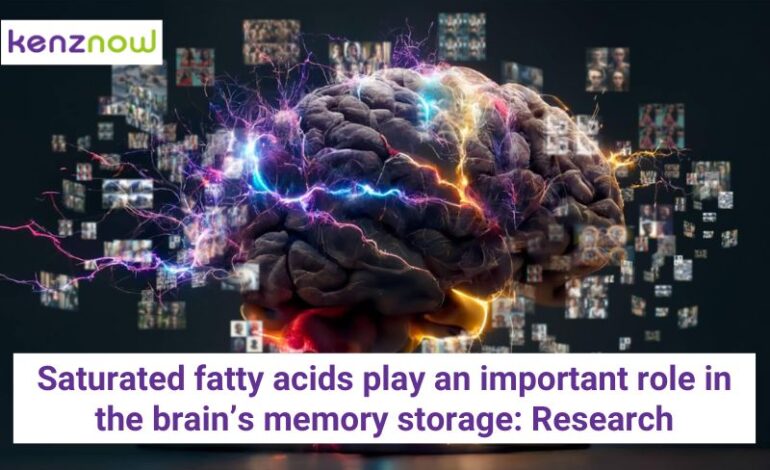Saturated fatty acids play an important role in the brain’s memory storage: Research – Kenznow

પ્રિય મિત્રો
સુપ્રભાત
Welcome to Kenznow Newsletter
CAMPUS STORY
Saturated fatty acids play an important role in the brain’s memory storage: Research
Source: University of Queensland
Researchers at the University of Queensland discovered that saturated fatty acids play an important function in memory preservation in the brain. Dr Isaac Akefe of the Queensland Brain Institute led the study, which revealed the genes important for memory formation. Their findings, published in the EMBO Journal, shed light on the mechanisms that drive memory development.
The researchers discovered that saturated fatty acids rise in the brain during synaptic communication, with an enzyme called Phospholipase A1 (PLA1) interacting with the protein STXBP1 at synapses to create these fatty acids. The brain, the body’s fattest organ, is dependent on lipids, notably fatty acids, for proper operation.

Professor Meunier said that to investigate the role of free fatty acids in memory formation, they employed mice models with the PLAl gene deleted. They studied the development and course of neurological and cognitive deterioration during their entire lives. Even before their memory was damaged, the team discovered that their saturated fatty acid levels were considerably lower than those of control mice. This suggests that the PLAl enzyme and the fatty acids it produces play a critical role in memory acquisition. This route is a promising target for treating neurodegenerative diseases such as Alzheimer’s.
The study’s significance stems from its implications for memory formation and the possibility of developing new therapeutics for neurological illnesses. Sabre Abd Elkader and Benjamin Matthews, PhD candidates, contributed to the study, which was conducted in partnership with numerous institutions, including the University of New South Wales and the Scripps Research Institute.
HEARD ON WEB
Samsung collaborates with Princeton University to research 6G.

Source: University of Princeton
Samsung Explore America (SRA) has partnered with Princeton University to explore and develop 6G technologies. Princeton, an Ivy League research institute, has its own NextG Initiative Corporate Affiliates Programme, which is focused on researching and developing the next generation of wireless technology, 6G. Princeton launched the program to accelerate the adoption of emerging technologies in a variety of areas, including cloud and edge networks, network resilience, and intelligent sensing.
Samsung Research America will now collaborate closely with Princeton University to reduce the gap between academic research and practical applications. Other firms that will participate include Intel, MediaTek, Ericsson, Nokia Bell Labs, Vodafone, and Qualcomm Technologies.
The commercial debut of 6G is still years away (estimated for 2029). However, sophisticated research and collaboration among academics, politicians, and industry participants are critical to its success. Samsung has already been doing 6G research, and in May 2019, it established the Advanced Communications Research Paper (ACRC) inside Samsung Research to spearhead the development of next-generation communications technology. ACRC previously issued a 6G whitepaper in July 2020 and a 6G Spectrum White Paper in May 2022.
6G is intended to give up to 1000 times the speed of 5G while also enabling human-machine collaboration via sensors.
PASSING BY
AIIMS Delhi and the University of Liverpool collaborate for research on head and neck cancer

Source: University of Liverpool
Union Health Minister Dr. Mansukh Mandaviya presided over the signing of a Collaboration Agreement between the University of Liverpool and AIIMS New Delhi for “AIIMS Liverpool Collaborative Centre for Translational Research in Head and Neck Cancer – ALHNS”.
This initiative seeks to leverage the strengths of two leading centers of head-neck oncology that enjoy global reputations and leadership positions in their respective geographies.
“AIIMS-University of Liverpool Collaborative Centre for Translational Research in Head- Neck Cancer” builds upon the pre-existing collaboration and links between the Liverpool Head and Neck Centre (LNHC), University of Liverpool (UOL) and the Head and Neck Cancer unit at AIIMS New Delhi.
The initiative will impact the care of patients with head and neck cancer by combining resources at both institutions to develop joint research and education programs which will enhance the quality of research outputs and education.
TRIVIA
Know the Language
GUJARATI
Gujarati is an Indo-Aryan language native to the Indian state of Gujarat and is also spoken in neighboring regions. It belongs to the larger Indo-European language family. With a rich literary tradition dating back centuries, Gujarati has its own distinct script, which is derived from the Devanagari script. It’s spoken by millions worldwide, primarily in Gujarat, as well as in communities across India and in diaspora communities around the globe. Gujarati is known for its diverse vocabulary, including influences from Sanskrit, Persian, Arabic, and English, reflecting its history of interactions with various cultures.
Till next issue.
તમને ફરી મલીસુ!
Team Kenznow



